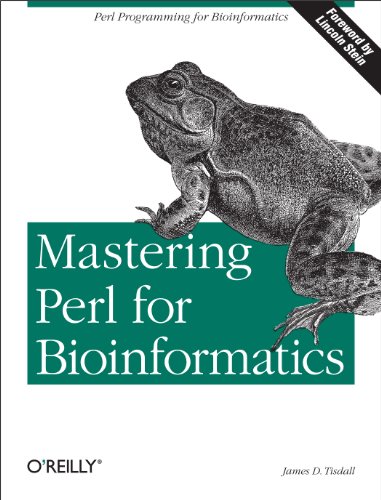Articoli correlati a Mastering Perl for Bioinformatics

Sinossi
Historically, programming hasn't been considered a critical skill for biologists. But now, with access to vast amounts of biological data contained in public databases, programming skills are increasingly in strong demand in biology research and development. Perl, with its highly developed capacities in string handling, text processing, networking, and rapid prototyping, has emerged as the programming language of choice for biological data analysis. Mastering Perl for Bioinformatics covers the core Perl language and many of its module extensions, presenting them in the context of biological data and problems of pressing interest to the biological community. This book, along with Beginning Perl for Bioinformatics, forms a basic course in Perl programming. This second volume finishes the basic Perl tutorial material (references, complex data structures, object-oriented programming, use of modules--all presented in a biological context) and presents some advanced topics of considerable interest in bioinformatics. The range of topics covered in Mastering Perl for Bioinformatics prepares the reader for enduring and emerging developments in critical areas of bioinformatics programming such as:
- Gene finding
- String alignment
- Methods of data storage and retrieval (SML and databases)
- Modeling of networks (graphs and Petri nets)
- Graphics (Tk)
- Parallelization
- Interfacing with other programming languages
- Statistics (PDL)
- Protein structure determination
- Biological models of computation (DNA Computers)
Le informazioni nella sezione "Riassunto" possono far riferimento a edizioni diverse di questo titolo.
Informazioni sull?autore
James Tisdall has worked as a musician, a programmer at Bell Labs (where he programmed for speech research and discovered a formal language for musical rhythm), and as a bioinformaticist at Mercator Genetics in Menlo Park, California, and at Fox Chase Cancer Center in Philadelphia. He has a B.A. in mathematics from the City College of New York and an M.S. in computer science from Columbia University; he is working towards a Ph.D. in computer science at the University of Pennsylvania. In his spare time, Jim teaches computer music at the Settlement Music School in Philadelphia. He is also the author of O'Reilly's Beginning Perl for Bioinformatics.
Le informazioni nella sezione "Su questo libro" possono far riferimento a edizioni diverse di questo titolo.
GRATIS per la spedizione in U.S.A.
Destinazione, tempi e costiCompra nuovo
Visualizza questo articoloEUR 3,43 per la spedizione in U.S.A.
Destinazione, tempi e costiRisultati della ricerca per Mastering Perl for Bioinformatics
Mastering Perl for Bioinformatics: Perl Programming for Bioinformatics
Da: BooksRun, Philadelphia, PA, U.S.A.
Paperback. Condizione: Fair. 1. The item might be beaten up but readable. May contain markings or highlighting, as well as stains, bent corners, or any other major defect, but the text is not obscured in any way. Codice articolo 0596003072-7-1
Quantità: 1 disponibili
Mastering Perl for Bioinformatics : Perl Programming for Bioinformatics
Da: Better World Books, Mishawaka, IN, U.S.A.
Condizione: Good. 1st Edition. Used book that is in clean, average condition without any missing pages. Codice articolo GRP82550252
Quantità: 3 disponibili
Mastering Perl for Bioinformatics: Perl Programming for Bioinformatics
Da: ThriftBooks-Atlanta, AUSTELL, GA, U.S.A.
Paperback. Condizione: Fair. No Jacket. Readable copy. Pages may have considerable notes/highlighting. ~ ThriftBooks: Read More, Spend Less. Codice articolo G0596003072I5N00
Quantità: 1 disponibili
Mastering Perl for Bioinformatics: Perl Programming for Bioinformatics
Da: ThriftBooks-Atlanta, AUSTELL, GA, U.S.A.
Paperback. Condizione: Good. No Jacket. Pages can have notes/highlighting. Spine may show signs of wear. ~ ThriftBooks: Read More, Spend Less. Codice articolo G0596003072I3N00
Quantità: 1 disponibili
Mastering Perl for Bioinformatics: Perl Programming for Bioinformatics
Da: ThriftBooks-Dallas, Dallas, TX, U.S.A.
Paperback. Condizione: Good. No Jacket. Pages can have notes/highlighting. Spine may show signs of wear. ~ ThriftBooks: Read More, Spend Less. Codice articolo G0596003072I3N00
Quantità: 1 disponibili
Mastering Perl for Bioinformatics
Da: HPB-Red, Dallas, TX, U.S.A.
paperback. Condizione: Good. Connecting readers with great books since 1972! Used textbooks may not include companion materials such as access codes, etc. May have some wear or writing/highlighting. We ship orders daily and Customer Service is our top priority! Codice articolo S_357158413
Quantità: 1 disponibili
Mastering Perl for Bioinformatics Perl Programming for Bioinformatics
Da: TextbookRush, Grandview Heights, OH, U.S.A.
Condizione: Acceptable. Expedited orders RECEIVED in 1-5 business days within the United States. Orders ship SAME or NEXT business day. We proudly ship to APO/FPO addresses. 100% Satisfaction Guaranteed! Codice articolo 44385587
Quantità: 1 disponibili
Mastering Perl for Bioinformatics Perl Programming for Bioinformatics
Da: TextbookRush, Grandview Heights, OH, U.S.A.
Condizione: Very Good. Ships SAME or NEXT business day. We Ship to APO/FPO addr. Choose EXPEDITED shipping and receive in 2-5 business days within the United States. See our member profile for customer support contact info. We have an easy return policy. Codice articolo 47093443
Quantità: 1 disponibili
Mastering Perl for Bioinformatics
Da: GreatBookPrices, Columbia, MD, U.S.A.
Condizione: As New. Unread book in perfect condition. Codice articolo 1187271
Quantità: 1 disponibili
Mastering Perl for Bioinformatics
Da: Lakeside Books, Benton Harbor, MI, U.S.A.
Condizione: New. Brand New! Not Overstocks or Low Quality Book Club Editions! Direct From the Publisher! We're not a giant, faceless warehouse organization! We're a small town bookstore that loves books and loves it's customers! Buy from Lakeside Books! Codice articolo OTF-S-9780596003074
Quantità: Più di 20 disponibili

